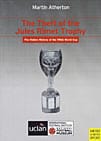 The Hidden History of the 1966 World Cup
The Hidden History of the 1966 World Cup
by Martin Atherton
Meyer & Meyer, £17.95
Reviewed by Josh Widdicombe
From WSC 256 June 2008
In 1997, FIFA paid £254,000 at auction for a replica of the Jules Rimet Trophy, possibly believing it to be the real thing. It wasn’t. Since 2000 Martin Atherton has been investigating how the incidents surrounding the theft of the trophy in 1966 led to this purchase decades later. A tale of intrigue, scheming and a black-and-white cross-breed called Pickles, it is equal parts Ealing comedy and an episode of Spooks.
Whether an opportunistic crime or student rag-week prank, the theft set off a string of incidents. These left two, or possibly even three, versions of the Jules Rimet trophy circulating the globe. Meanwhile, a man who claimed he was a go-between was sitting in prison and England’s team celebrated World Cup victory with a fake trophy as the real one sat safely in the possession of the police.
It was a time when English institutions were ruled by pompous buffoons, none more so than the FA, who first allowed the trophy to be exhibited at a stamp show with lax security and then, when it was stolen, commissioned a replacement behind FIFA’s back. After a man attempting to claim a ransom for the trophy was arrested and it was found by a dog, the FA went ahead with having the fake made anyway. That is just the beginning.
Atherton’s research is amply rewarded in the fine details, which speak far more of the amateurism on all sides than any narrative would. Police officers were chosen for undercover work simply because they didn’t look like bobbies; after recovery, the trophy was often transported around London in the basket of trophy-maker George Bird’s bicycle; while the bank notes offered to pay the ransom were just bundles of paper with £20 notes on either end – a tactic I didn’t realise had ever been used outside of Minder.
While the story rattles along once it is going, Atherton’s attempts to link the scandal to the broader social context of the 1960s are slightly forced. Far too much has been written about that decade over the years and the story is strong enough to stand on its own without the need for wider plotting. Unsurprisingly we are left with as many questions as answers, but this is a good thing. There is no need for the author to draw conclusions from the evidence when the reader can do that themselves. Did students steal the trophy as a prank? Did the FA plan to replace the cup without FIFA knowing? Did FIFA fork out for the fake cup because they thought it might be the real deal? It wouldn’t be the strangest part of the story.